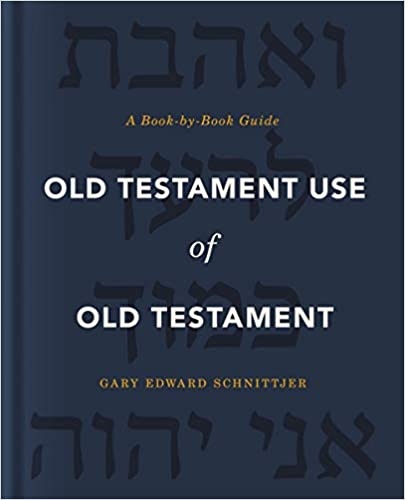An Author Interview from Books At a Glance
Would you like to watch the video interview or listen to the audio? Sign-up today for access to these features and more.
Greetings, I’m Fred Zaspel and welcome to another Author Interview here at Books At a Glance. Today we’re talking to Dr. Gary Schnittjer about his remarkable new book, Old Testament Use of Old Testament: A Book-By-Book Guide.
Gary, welcome back, and congratulations on this excellent new resource!
Schnittjer:
Thank you for having me. I appreciate it.
Zaspel:
What is your book all about, and what is the contribution you hope to make?
Schnittjer:
That’s a great question. I will unpack it in two ways. I will answer the way I would answer to a layperson at church and how I would answer to students. For a layperson, I would approach it in this way: when we read the Scriptures, and something jumps out you never had seen before, or sometimes we read the Scriptures and find another passage to help us interpret the Scriptures. Those two things aren’t just our experiences as Christians. Those things go all the way back into the biblical period. Biblical authors saw new things by God’s Spirit and often connected one Scripture with another. My book traces out that phenomenon within the Old Testament.
I might answer students differently. The big category focuses on progressive revelation and how Scriptural exegesis of Scripture fits within progressive revelation. Progressive revelation is short for the progressive revelation of God’s redemptive will. It focuses on that small subset of God’s progressive revelation. Not through prophets or great action but through biblical authors who say something new considering previous revelation of God in the Scriptures.
Zaspel:
We who preach and teach the Scriptures are taught from the beginning that our job is to interpret the biblical text faithfully. What we’re not always told is that the biblical writers themselves often did just that. And if we are told that, it’s almost always with reference to how the New Testament writers use the Old Testament. So, your book is a first of its kind, right?
Schnittjer:
The reason I chose Old Testament use of Old Testament is that a lot are familiar with New Testament use of the Old Testament. But what a lot of people do not get is that the New Testament authors learned to interpret the Scriptures by how the authors of their Scriptures interpreted Scriptures. One of the things that I think will be an outcome of this book is that it will demystify some of the strange uses of the Scriptures in the New Testament. People have been looking to the sectarian scrolls and various other places. A lot of these things are very commonplace in an Old Testament use of Scripture.
Zaspel:
Before we take up some samples, talk to us about the various ways Old Testament writers make use of earlier biblical writings, and explain for us the difference between citation, allusion, and such.
Schnittjer:
We can start with the mechanical side of things. There is a sliding scale from quotation, to paraphrase, to allusion, to echo, to trace. The big watershed is between allusion and echo because allusions are inclusive of paraphrases and quotations. They are intentional, the author meant to do it. It was very purposeful. We as readers become unsure when we talk about an echo. Did the author mean to do it or was it an accident where we are reading into the text?
This book focuses on allusions, and I try to show ones that are not imagined but real. Especially exegetical allusion. The author is not just referring to something but doing something with the Scripture the author refers to. Besides the mechanical, the other thing to keep in mind is the question of what attracted the authors to this. We think more about internal triggers and external triggers. Previous revelation of God calls for more revelation. Some things we struggle with, we are not the first ones to struggle with. We think of the attribute formula, for example, we see the great part of “the Lord, the Lord, gracious and merciful.” What about the bringing on of judgment on the children and children’s children? Biblical authors went back to texts like that again and again.
External triggers are easier to spot. Those are things like the exile. A devastating judgment of God upon his people that really called into question everything the people thought they believe. What do the Abrahamic or Davidic covenant mean in exile? We have large-scale interpretation of earlier Scripture and the prophets. The only thing on that same scale but larger is the death and resurrection of the Messiah in the New Testament. That cataclysmic event drove the biblical authors to search the Scriptures and make sense of what God was doing.
Zaspel:
Were there any surprises in the process of your work as to how biblical writers handle earlier passages of Scripture? Just broadly, what can we learn from them on that level?
Schnittjer:
Because of the scale of this book, there were a lot of surprises. One surprise for me was that this idea of reinterpreting the Scriptures can be upsetting to us as Bible readers. It is Yahweh himself who sets the precedent and initiates this. In the Torah, there are five special stories. One is on the very first Passover in Numbers 9. Some were impure after burying someone who died. They came to Moses and wanted to know why they could not come to the Passover just because someone died. So, he set up an alternate Passover date for people who were traveling or ritually impure.
Another one in Numbers is when Zelophehad died and left behind daughters. They complained to the tribal leaders and Moses and wanted an inheritance too just like the men. They made provisions for this situation so they could inherit. The tribal leaders of Manasseh came back in Numbers 36 and wanted to make sure the land was not depleted from giving the inheritance to the daughters. The Lord tweaks his own tweak on this plan. The daughters can inherit the land, but they must marry inside of Manasseh to retain the land. We see these interpretations of the Scripture, advancing revelation. This was not something the human authors did themselves. The precedents are set by the Lord.
Zaspel:
Give us some samples that will illustrate the value of this kind of work. Just pick two or three to show us how later Old Testament writers make use of earlier revelation.
Schnittjer:
One I was not aware of was the famous command love thy neighbor. It turns out it is not out of new cloth. It relies upon a series of exegetical steps that came before. At the end of Leviticus 19, they are commanded to “love the residing foreigner.” That love depends upon an interpretive blend that is reading one text from Exodus, the command of the Passover in the light of another command from Exodus, the covenant collection. At Passover, one of the laws in Exodus 12:48 says, “the circumcised residing foreigner is to participate in Passover just like the native born.”
There is a prohibition in Exodus 22 against mistreating residing foreigners. They were to not mistreat them because they were residing foreigners. It brings these two things together. In Leviticus 19:33-34, there is the same command. The bringing together of these texts gave rise to a new revelation. The next step is important and common in the Bible. The lesser to the greater concept is, if you shall love the residing foreigner then you must love your neighbor. It unfolds right out of this revelation.
Zaspel:
Tell us how you approach your work in the book so our listeners can know what to expect.
Schnittjer:
Many of the other studies in this area are focused on a certain kind of interpretive element in the Old Testament or certain books of the Bible. This book goes through each one of the scrolls in the Old Testament, Genesis through Chronicles. There is a chapter on all of them. The focus is on how this author uses Scripture. These chapters give the readers an opportunity to think with the biblical authors so they can come to a book of the Bible.
The beginning of each chapter has a hermeneutical profile of the use of Scripture of book X. it gives an overview of the hermeneutical tendencies of this author. The rest of the chapter is case by case going through these exegetical allusions. One thing that surprised me was not about the Bible but in the publishing world. At the end of each chapter, there are filters. Zondervan let me publish the filters. A lot of times when we read a book like this we wonder if everything in it is what the person saw. The filters filter off the plethora of other similar passages. Then the focus of the chapter can be on the exegetical use of previous Scriptures.
Zaspel:
Is it necessary for readers to know Hebrew to profit from your book?
Schnittjer:
There is plenty of Hebrew in the book, but the entire book is meant for English Bible readers. Any English Bible reader that opens the text and gets scared, knows that the Hebrew words can all be skipped over. Everything in Hebrew is translated. The stuff in Hebrew appears occasionally in parentheses. A lot of us had a chance to study biblical Hebrew in seminary. It is to help those who studied Hebrew, so they know what they need to lookup.
Zaspel:
We’re talking to Dr. Gary Schnittjer about his new landmark book, Old Testament Use of Old Testament: A Book-By-Book Guide. It’s a really valuable resource – one of those tools every expositor will want to keep handy at his desk.
Gary, thanks for your great work, and thanks for talking to us today.
Schnittjer:
Thanks for having me on. It has been good to be with you today.

